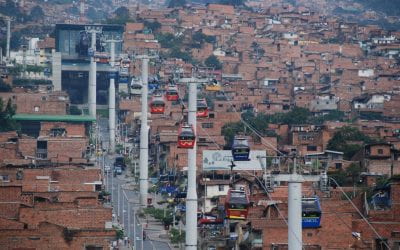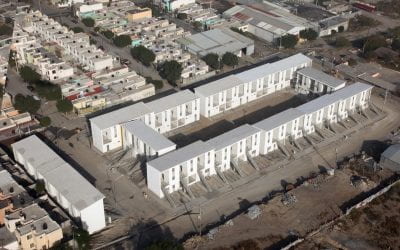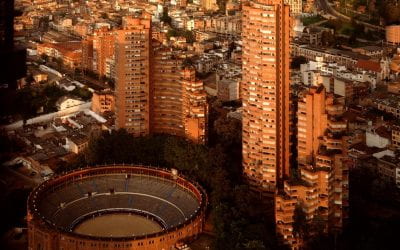Designing Urban Opportunities
Games and Integration
Imagine a gaggle of eight-year-olds chasing each other on a playground they helped design themselves. Imagine an enthusiastic team of teenagers trying to kick a ball just like their soccer star hero Diego Armando Maradona. Imagine a colorful mural filled with flowers and angels.
As you, the visitor to a Buenos Aires villa de emergencia, approach, you see this is no ordinary mural. The mural, between depictions of angels and flowers, displays publicly the names of those youth who for all these years were only remembered in the grief of family intimacy. Families of the victims participated by bringing in their memories and stories. Today, the space is being transformed into a place for sports and leisure activities. However, the identification of the space as a public area that belongs to the community was defined before the first brick was laid.
Discovering the slums of Buenos Aires—known by the poetic name of villas de emergencia(emergency dwellings)—is to experience a space where the city constructs itself on a daily basis. Here, one is most likely to observe need and economic incapacity. Soon, however, the visitor finds another type of experience: villas de emergencia are places where generations of residents have consolidated a defined communitarian structure in the daily life of the neighborhood.
To capitalize on that already-existing sense of community, we have been developing this capacity of “games” in the villas where we are working in Buenos Aires. Many different types of events are programmed to define where and how to construct this new network of activities. Youth participate in this decision-making through their written opinions, as well as through drawings and photographs. They have a voice in deciding what should be constructed and where. This process of early involvement is important because it attracted the attention of adults who would directly or indirectly become part of the transformation.
One of the first activities was painting a mural in one of the most difficult neighborhoods. Both poverty and daily violence made the neighborhood particularly challenging, but the project managed to involve youth with records of violence; muralists led by artists and social workers consolidated a working group. The subject matter developed by them set out to show the violence of the neighborhood by honoring the memory of those who had lost their lives to violence.
Many of these cultural happenings help construct a space of daily coexistence, putting into place not only physical and social improvement of the urban area, but creating the integrative capacity of making the villas part of the city. It is precisely their own culture that identifies them as community, where the possibility exists of transforming these discriminatory processes.
Many institutions are trying to consolidate spaces where residents can define their own identity. These range from various religious institutions to sports facilities where soccer provides a place to get together, as well as a symbol of progress.
Soccer star Diego Armando Maradona is the most prominent symbol since he overcame his humble upbringing to achieve international recognition. To villeros, he is a hero and an example to follow. However, he is far from the only villa resident who has used sports to break the barriers of poverty; many soccer idols have been able to rescue relatives from poverty through their participation in the great national sport of soccer.
But the sport also permits villa residents to participate in regional tournaments, broadening their world, as well as to engage in spontaneous competition in their own neighborhoods.
“Games” of all sorts, that is, recreational activities, are spaces that permit integration, according to their scale, spaces and communities, because they propose different ways of re-utilizing urban space in the context of tacit or predefined agreements of social co-existence.
It’s not just in Argentina. A good example of how games and the involvement of youth led to the recuperation of socially disarticulated urban space can be found in the projects of Dutch architect Aldo van Eyck, who constructed 700 playgrounds in Amsterdam after World War II. Through these play spaces, he helped repair a morally and socially devastated city, through its youngest citizens. The youth were the motor of the process of physical and social recuperation, returning to the city its status as a community.
In Buenos Aires, these villas de emergencia continue to be hidden away and not integrated into the city as a whole. In part, that’s because of structual poverty, but it is also because most non-dwellers are afraid to venture into the villas because they see them as dangerous places.
Villas, precisely because they are precarious and illegal settlements with high crime rates, represent a strange and terrifying urban space for the residents of the “formal” city. Thus, villa residents suffer a stigma that goes beyond their condition of poverty. It is not only economic distance that separates them from the rest of society, but the suspicion of criminality.
“Villeros,” as villa residents are called, are seen from the outside in a derogatory fashion. Nevetheless, their status as “villeros” is resignified within the villa itself and adopted as a badge of communitarian identity. Survival techniques adopted by villa residents range from the symbolic and cultural appropriation of a “villero” identity to the imprint of this identity on cultural products and communitarian institutions. Games that involve community participation, along with neighborhood involvement in the design of community leisure space, bring youth into the life of the community and the community into the life of the city.
This experience shows us a possible path, obviously not the only only one, but a way to a flexible system, suitable for consolidation through games. Through youth and youth activities, it is possible to find a model of urban integration in areas and societies that are struggling to be recognized as part of the city.
Spring | Summer 2010, Volume IX, Number 2
Flavio Janches, a 2007-08 De Fortabat Visiting Scholar at the David Rockefeller Center for Latin American Studies, is a partner at the A:BJ&C Architecture firm in Buenos Aires, Argentina, and Professor of Architecture and Urban Design at the University of Buenos Aires.
Related Articles
Architecture: Editor’s Letter
For years, readers have been commenting on the printed edition of ReVista: “How beautiful!” Now here’s a website to match, thanks to the efforts of the design firm 2communiqué and Kit Barron of DRCLAS. It’s not only a question of reflecting the aesthetics of the printed…
Working in the Antipodes
I was asked by ReVista to write an article on my own work, specifically about the fact that I do simultaneous work on social housing and high-profile architectural projects, something that is, to…
Three Tall Buildings
I used to hate the three tall towers that thrust against the verdant mountains. I used to think that the red brick towers dug into the landscape, belonging to some other city and some other space, created a scar of modernity…





